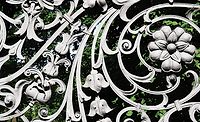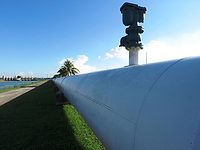Sustained Success: From Smart Additives to Smart Powder Coatings

The area of powder coatings continues to grow and develop at a great pace through continuous innovation. The powder coatings market represents about 10-15% of the global coatings market ($17 billion+ by 2025), 1 and new application sectors are being explored as new additives arrive on the market place. Raw material suppliers have to rise to the challenge, to help applicators and manufacturers meet the new demands of powder coating customers. Some key challenges for future powder coatings include displacing VOC coatings for a low environmental footprint; improving flow and edge cover properties; improving cure temperatures and times, which in turn will allow for expanding the types of materials that can be coated (e.g. plastic, wood, fiberboard); lower energy consumption during application; and corrosion protection, 2 which remains a key area of interest with a desire for improvement across the industry.
Corrosion protection in powder coating is governed by a few key parameters. First and foremost is substrate preparation. Correct and appropriate pre-treatment and substrate cleaning will ensure consistent corrosion performance directly correlated to the level of adhesion achieved. 3 The second key parameter is the relative impermeability of powder coatings. Water penetration into the coating and towards the substrate surface is dramatically slower than with conventional liquid coatings. This is due to the high crosslink density of thermoset polymers. This helps to slow the onset of corrosion, but the extent of the moisture penetration through the coating is also affected by a number of other factors including, but not limited to, thickness of the coating, cure, coating chemistry and pigment loading. As the market for powder coatings grows, so too does the ambition for what powder coatings can achieve.
One key component for corrosion control is the choice of anticorrosive additives. There are very few additives that are suitable for powder coatings to help mitigate corrosion or reduce corrosion potential. This limitation is primarily due to the excellent corrosion resistance already natively provided by thermoset powder coatings. The vast majority of the corrosion resistance enhancement additives successfully marketed and sold into the liquid coatings industry do not provide enhancement to thermoset coatings in levels that can be consistently demonstrated as quantifiably improved systems. For example, a silane adhesion promotor used in a liquid system can nearly double corrosion resistance in a liquid paint system by dramatically increasing the paint-to-substrate adhesion. The same additive will demonstrate little to no quantifiable improvement when incorporated into an industry-standard TGIC cured polyester thermoset coating since the adhesion capabilities are already vastly superior to what the silane-enhanced liquid coating provides.
Of the few additives available to thermoset coating manufacturers, zinc pigment is by far the most common. Zinc-rich coatings have very high pigment loadings (>50%) due to the amount of zinc required to achieve a galvanizing effect. In addition, zinc is classified as a heavy metal, and coatings containing such high heavy metal levels attract environmental hazard labels (for soil and water contamination i.e. GHS “dead fish dead tree label”). With increased awareness about the environmental impact of heavy metals, it is advantageous to be able to create products with reduced labelling requirements relative to zinc-rich coatings.
New Developments
Inhibispheres ® are a new class of corrosion inhibitors for powder coatings. 4-6 Inhibispheres utilize a sustained release technology based on corrosion inhibitor microencapsulation via a silica matrix. These organic and metal-organic corrosion inhibitors are more efficient than current heavy metal-based corrosion inhibitors. The particles are mechanically tough and can survive the strong mechanical forces experienced during the powder extrusion process. They are also thermally stable, surviving the processing temperatures associated with powder coating manufacturing as well as post curing. They work by releasing the inhibitor by solubilization when moisture penetrates through the coating either by rupture (crack/scratch) or through condensation. With regard to labelling, Inhibispheres are low-impact products that do not require any additional hazard or environmental labelling.
There is still a current and growing need for powder coatings that can offer superior corrosion resistance on steel substrates, without the laborious and expensive process of using a zinc-rich primer. The development of the Smart Seal product is unique in powder coatings, providing a single-coat system that is zinc free and can give a performance enhancement well above and beyond what is currently available on the market in single-coat application systems. This single-coat system utilizes the sustained release characteristics of Inhibispheres to improve its corrosion protection potential. This is an excellent alternative to zinc primer systems where enhanced corrosion protection is required, and a two-coat system is difficult or impossible to implement. B117 neutral salt fog testing has demonstrated corrosion resistance of Smart Seal powder to be double that of an industry-standard TGIC cured polyester system.
Formulation
Erie Powder Coatings’ Smart Seal product is a unique advancement in powder coating formulation. The Smart Seal product utilizes Inhibispheres to give a one-coat system with comparable corrosion performance to a two-coat, zinc-rich coating system without compromising on the optical or mechanical properties. Inhibispheres corrosion inhibitors have been incorporated into a super-durable (PIA) polyester coating. The Inhibispheres were incorporated into the premix and melt-mix extruded at 120 °C. The product easily disperses into the mix, causing no quantifiable impairment on throughput when using single-screw or twin-screw extruders. In testing, three different coating systems were prepared (Table 1), applied (Table 2) and compared for their corrosion performance (Table 3) and coating properties (Table 4).
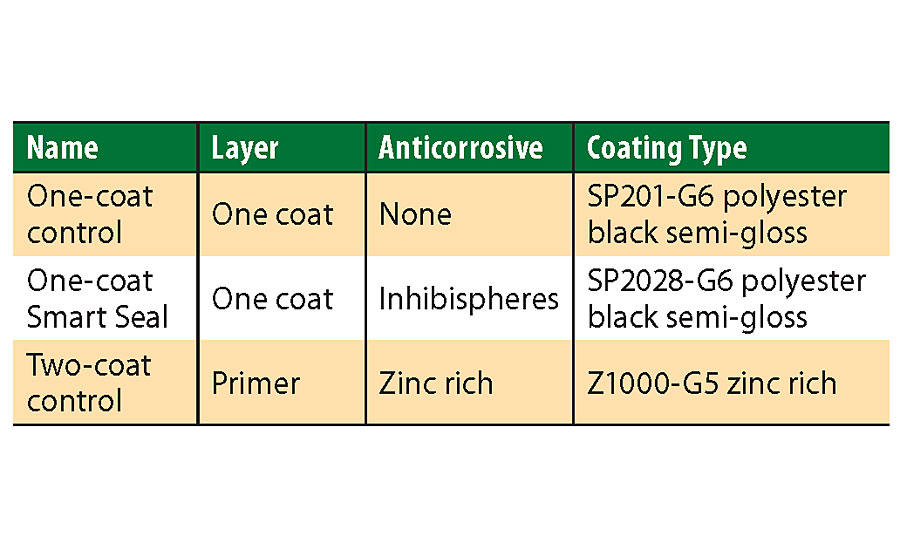

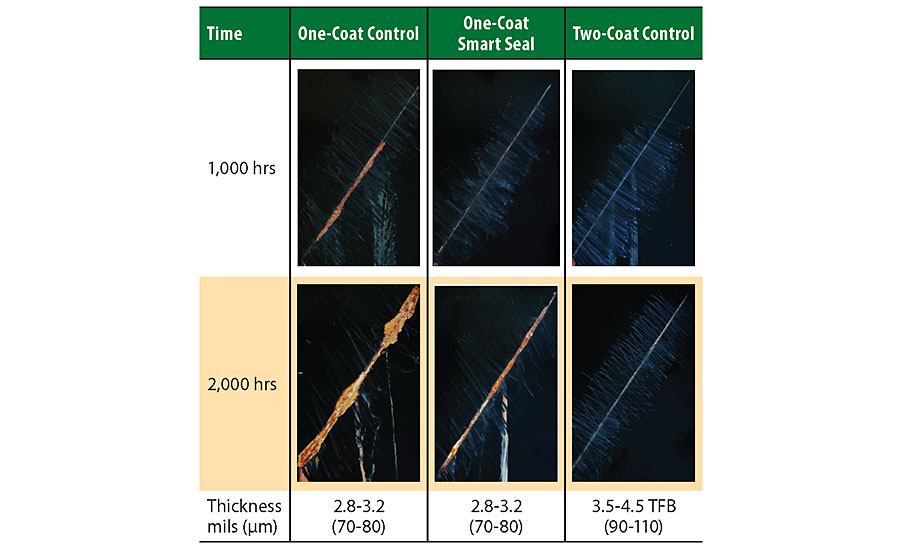
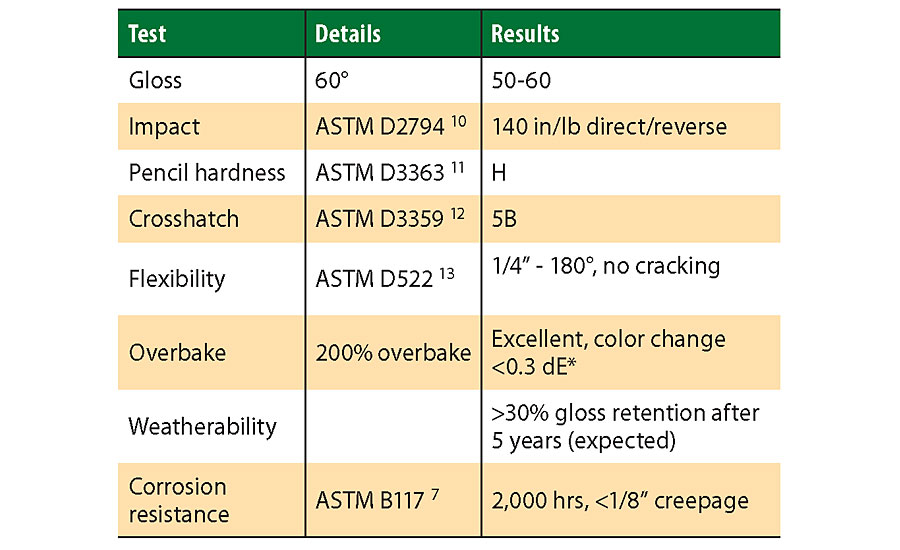
Application Parameters
The one-coat systems were applied on 7-stage treated cold rolled steel and were sprayed using a manual electrostatic spray gun to give a film build of 70-80 micron (2.8-3.2 mil) on all panels. The two-coat system was built up to a primer coat of 40-50 micron (1.5-2.0 mil) and a topcoat of 50-60 micron (2.0-2.5 mil) to give an overall coating thickness of 90-110 micron (3.5-4.5 mil), as seen in Figure 1. The primer system was a zinc-rich-based polyester, and the topcoat system was a superdurable (PIA) polyester, which gives excellent performance in salt spray testing with a performance rated for >2,000 hrs.
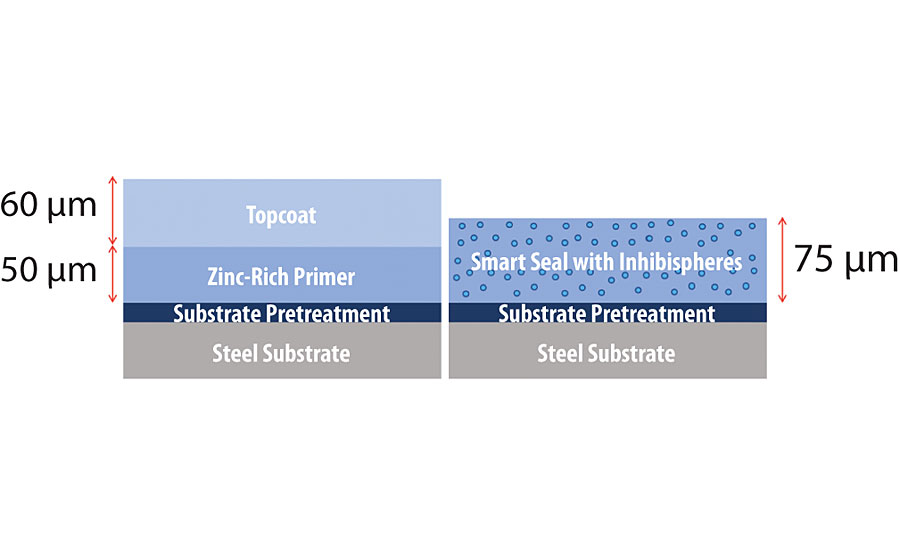
Corrosion Performance
Corrosion testing was performed using a NSST running according to ASTM B117. 7 The panels were scribed down to the metal substrate and then exposed for 1,000/2,000 hrs in the salt spray tank. The test panels were examined at intervals through the corrosion testing regime, and the scribe condition was rated for corrosion following the methodology laid out ASTM D1654. 8
The inclusion of Inhibispheres as an anti-corrosive agent has improved the corrosion resistance of the coating to allow for similar performance with a two-coat system utilizing a single coat. The corrosion performance can be seen at the different intervals in the images in Tab. 3. It is clear there is a significant performance improvement from the one-coat control when compared against the Smart Seal coating at both 1,000 and 2,000 hrs in salt spray testing. A comparison of the Smart Seal product against the two-coat control shows slightly reduced performance but is still comparable for corrosion control. Both systems have less than 1/8 inch (3 mm) undercutting (creep) from the scribe at 2,000 hrs. This is a significant achievement for a single-coat zinc-free system.
Mechanical and Optical Properties
The mechanical and optical properties of the coatings were unaffected by the addition of Inhibispheres. Cross hatch testing (5B) as well as pencil hardness (H) indicate no change when compared against the control coatings. The incorporation of the Inhibispheres also had little to no effect on the optical properties of the coatings. The gloss and color remained stable throughout formulation, curing and testing. A semigloss finish was achieved with a one-coat system that is comparable to a two-coat system with a semigloss topcoat. As Inhibispheres have little to no effect on the gloss it is possible to formulate a high-gloss coating in a single-coat product while maintaining corrosion performance (Tab. 4).
Coating Applications
Any steel substrate requiring superior corrosion resistance to that offered by any current single-stage system is a prime candidate for the Smart Seal line of corrosion-resistant powder coatings formulated with Inhibispheres technology. If a two-stage, zinc-based corrosion process is not desired, or not possible due to safety concerns, Smart Seal powder is highly recommended as an excellent alternative. In addition to offering nearly the anticorrosive performance of a two-stage zinc system, Smart Seal powder cuts the application process time in half. This not only simplifies processes for applicators, but also removes any risk of intercoat delamination inherent to zinc primers. Reduced application time and dramatic reduction in potential re-working will lead to substantial reduction in costs.
Agricultural equipment lifespans can be extended, substrates exposed to harsh salted winter roadways can be in service longer and decorative items placed in exterior conditions can stay beautiful for prolonged periods. If rust is a concern, Smart Seal powder coatings with Inhibispheres technology could be the solution.
Conclusions
In general, powder coatings have excellent adhesion and corrosion properties on steel. The best products will achieve 1,000 hrs with 3 mm (1/8”) undercut from a scribe on ASTM B117 salt spray testing, on 7-stage treated cold rolled steel. However, there has never been a zinc-free product that would substantially pass 1,000 hrs in salt spray testing. Other competitive products that were tested extensively and that have been highly rated still only achieve ~1,000 hrs. Erie Powder Coatings has produced the Smart Seal product line utilizing Ceramisphere’s new Inhibispheres sustained-release corrosion technology. The addition of Inhibispheres to this coating allows for the creation of a single-coat system with unique properties that can give nearly the same level of corrosion protection as a two-coat system. This provides significant cost savings for the applicator in terms of time and coating cycles necessary to achieve optimum protection. Moreover, the coatings are environmentally friendly and do not attract additional safety labels. The collaborative effort between Ceramisphere and Erie Powder Coatings has helped to bring a superior corrosion protection powder product to the marketplace. This interaction between additive and paint manufacturers has generated exceptional results and helped to further innovation in the powder coating market place.
References
1 Locicero, A. Coatings World, Nov 2019, pg. 29-32.
2 Challener, C. CoatingsTech, Vol. 15, No. 8, Aug 2018, pg. 32-39.
3 Chalk, D.B. Powder Coating Tough, Jan-Feb 2020, pg. 16-20.
4 Noble-Judge, A.; Barbé, C. Paint and Coatings Industry, Oct 2016, pg. 22-26.
5 Noble-Judge, A.; Barbé, C. Paint and Coatings Industry, Feb 2019, pg. 26-31.
6 Noble-Judge, A.; Barbé, C. Paint and Coatings Industry, Mar 2020, pg. 44-50.
7 ASTM B117 - Standard Practice for Operating Salt Spray (Fog) Apparatus.
8 ASTM D714 – Standard Test Method for Evaluating Degree of Blistering of Paints.
9 ASTM D1654 - Standard Test Method for Evaluation of Painted or Coated.
10 ASTM D2794 - Standard Test Method for Resistance Of Organic Coatings To The Effects Of Rapid Deformation (Impact).
11 ASTM D3363 - Standard Test Method For Film Hardness By Pencil Test.
12 ASTM D3359 - Standard Test Methods for Rating Adhesion by Tape Test.
13 ASTM D522 - Standard Test Methods for Mandrel Bend Test of Attached Organic Coatings.
Looking for a reprint of this article?
From high-res PDFs to custom plaques, order your copy today!






